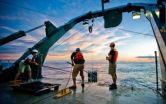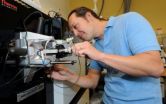(Press-News.org) For decades, doctors have developed methods to diagnose how different types of cells and systems in the body are functioning. Now scientists have adapted an emerging biomedical technique to study the vast body of the ocean.
In a paper published this week in the journal Science, scientists demonstrate that they can identify and measure proteins in the ocean, revealing how single-celled marine organisms and ocean ecosystems operate.
The National Science Foundation (NSF) and the Gordon and Betty Moore Foundation funded the research.
"Proteins are the molecules that catalyze the biochemical reactions happening in organisms," says Woods Hole Oceanographic Institution (WHOI) biogeochemist Mak Saito, the paper's lead author.
"Instead of just measuring what species are in the ocean, now we can look inside those organisms and see what biochemical reactions they're performing in the face of various ocean conditions.
"It's a potentially powerful tool we can use to reveal the inner biochemical workings of organisms in ocean ecosystems--and to start diagnosing how the oceans are responding to pollution, climate change and other shifts."
The emerging biomedical technique of measuring proteins--a field called proteomics--builds on the more familiar field of genomics that has allowed scientists to detect and identify genes in cells.
"Proteomics is an advanced diagnostic tool that allows us to take the pulse of, for example, phytoplankton cells while they respond to environmental cues," says paper co-author Anton Post, currently on leave from the Marine Biological Laboratory in Woods Hole, Mass., and a program officer in NSF's Division of Ocean Sciences.
The new study is an initial demonstration that proteomic techniques can be applied to marine species not only to identify the presence of proteins, but for the first time, to precisely count their numbers.
"We're leveraging that biomedical technology and translating it for use in the oceans," Saito says.
"Just as you'd analyze proteins in a blood test to get information on what's happening inside your body, proteomics gives us a new way to learn what's happening in ocean ecosystems, especially under multiple stresses and over large regions.
"With that information, we can identify changes, assess their effects on society and devise strategies to adapt."
For their study, the scientists collected water samples during a research cruise along a 2,500-mile stretch of the Pacific Ocean from Hawaii to Samoa.
The transect cut across regions with widely different concentrations of nutrients, from areas rich in iron to the north to areas near the equator that are rich in phosphorus and nitrogen but devoid of iron.
Back in the lab, the scientists analyzed the samples, focusing on proteins produced by one of the ocean's most abundant microbes, Prochlorococcus.
They used mass spectrometers to separate individual proteins in the samples, identifying them by their peptide sequences.
In subsequent steps, the scientists demonstrated for the first time that they could precisely measure the amounts of specific proteins in individual species at various locations in the ocean.
The results painted a picture of what factors were controlling microbial photosynthesis and growth and how the microbes were responding to different conditions over a large geographic region of the sea.
For example, in areas where nitrogen was limited, the scientists found high levels of a protein that transports urea, a form of nitrogen, which the microbes used to maximize their ability to obtain the essential nutrient.
In areas where iron was deficient, they found an abundance of proteins that help grab and transport iron.
"The microbes have biochemical systems that are ready to turn on to deal with low-nutrient situations," Saito says.
In areas in-between, where the microbes were starved for both nutrients, proteins indicated which biochemical machinery the microbes used to negotiate multiple environmental stresses.
The protein measurements enabled the scientists to map when, where, and how ecosystem changes occurred over broad areas of the ocean.
"We measured about 20 biomarkers that indicate metabolism, but we can scale up that capacity to measure many more simultaneously," Saito says.
"We're building an oceanic proteomic capability, which includes sampling with ocean-going robots, to allow us to diagnose the inner workings of ocean ecosystems and understand how they respond to global change."
INFORMATION:
Along with Saito and Post, the research team included Matthew McIlvin, Dawn Moran, Tyler Goepfert and Carl Lamborg of WHOI and Giacomo DiTullio of the College of Charleston in South Carolina.
Scientists apply biomedical technique to reveal changes in body of the ocean
Researchers look at biochemical reactions happening inside ocean organisms
2014-09-08
ELSE PRESS RELEASES FROM THIS DATE:
Faces are more likely to seem alive when we want to feel connected
2014-09-08
Feeling socially disconnected may lead us to lower our threshold for determining that another being is animate or alive, according to new research published in Psychological Science, a journal of the Association for Psychological Science.
"This increased sensitivity to animacy suggests that people are casting a wide net when looking for people they can possibly relate to — which may ultimately help them maximize opportunities to renew social connections," explains psychological scientist and lead researcher Katherine Powers of Dartmouth College.
These findings enhance ...
Bone cancer surgical team sees success in new application of surgical aid
2014-09-08
(9/8/14, Lebanon, NH) —An ortho-oncology team at Dartmouth-Hitchcock Norris Cotton Cancer Center successfully adapted a shoulder surgical aid (the Spider Limb Positioner) to conduct a left hip disarticulation on a melanoma patient as described in a case report published online in Medical Devices.
The Spider Limb Positioner is a pneumatic arm with three fully articulating joints that can be infinitely adjusted in relation to the operating table where it is mounted. The positioner mobilizes patients' limbs so surgeons don't have to, thereby freeing up both their hands ...
Study shows nationwide declines in central line infections and ventilator pneumonias
2014-09-08
Hospitals across the country have seen sharp declines in rates of central line-associated blood stream infections (CLABSIs) and ventilator-associated pneumonias (VAPs) among critically ill neonates and children, according to a new study in the journal Pediatrics.
The study, "Health care-associated infections among critically ill children in the U.S.," analyzed incidences rates of CLABSIs, VAPs and catheter-associated urinary tract infections (CAUTIs) for 173 neonatal intensive care units (NICUs) and 64 pediatric intensive care units (PICUs) from 2007-2012.
"Central ...
Pastors get scant seminary training on how to help mentally ill, Baylor study finds
2014-09-08
People struggling with mental illness often turn to pastors for help, but seminaries do very little to train ministers how to recognize serious psychological distress and when to refer someone to a doctor or psychologist, according to a Baylor University study.
As a result, "many people in congregations continue to suffer under well-meaning pastors who primarily tell them to pray harder or confess sin in relation to mental health problems," said lead researcher Matthew S. Stanford, Ph.D., professor of psychology and neuroscience in Baylor's College of Arts & Sciences.
The ...
Too many kids with asthma, food allergies lack school emergency plans
2014-09-08
CHICAGO --- Only one in four students with asthma and half of children with food allergies have emergency health management plans in place at school, leaving schools inadequately prepared to manage daily needs and handle medical emergencies related to often life-threatening medical conditions, reports a new Northwestern Medicine study in partnership with Chicago Public Schools (CPS).
"Given the amount of time kids spend in school, it's critical for school staff, clinicians and parents to make sure there's a health management plan in place for students with health conditions," ...
NASA catches the end of Tropical Depression 14W
2014-09-08
Tropical Depression 14W was a short-lived storm that only lasted through four bulletins from the Joint Typhoon Warning Center. NASA's Aqua satellite captured infrared data on the storm's cloud top temperatures as it passed over China's Hainan Island and headed toward a final landfall in mainland China.
Born in the South China Sea it made landfall in southeastern China on September 8. The Atmospheric Infrared Sounder instrument called AIRS that flies aboard NASA's Aqua satellite captured infrared data on the storm on September 7 at 1:59 a.m. EDT. The AIRS data showed an ...
NASA sees post-Tropical Cyclone Norbert fading near Baja California
2014-09-08
NASA's Aqua satellite passed over Tropical Storm Norbert on September 7 before it weakened to a post- tropical storm. The AIRS instrument aboard captured infrared data that showed a "sliver" of strong thunderstorms remained around the center of the waning storm.
When the Atmospheric Infrared Sounder or AIRS instrument gathered infrared data on Tropical Storm Norbert on Sept. 7 at 4:53 p.m. EDT, it showed only a small area of strong thunderstorms around the center where cloud top temperatures were near the -63F/-52C threshold for strong storms.
At that time, Norbert ...
A single evolutionary road may lead to Rome
2014-09-08
A well-known biologist once theorized that many roads led to Rome when it comes to two distantly related organisms evolving a similar trait. A new paper, published in Nature Communications, suggests that when it comes to evolving some traits – especially simple ones – there may be a shared gene, one road, that's the source.
Jason Gallant, MSU zoologist and the paper's first author, focused on butterflies to illustrate his metaphorical roadmap on evolutionary traits. Butterfly wings are important biological models. While some butterflies are poisonous and notify their ...
New antimicrobial strategy silences NDM-1 resistance gene in pathogens
2014-09-08
Researchers have synthesized a molecule that can silence the gene responsible for severe antibiotic resistance in some bacteria. The research, presented at the 54th Interscience Conference on Antimicrobial Agents and Chemotherapy (ICAAC), an infectious disease meeting of the American Society for Microbiology (ASM) could be a viable new strategy for treating resistant infections.
The focus of this new molecule is NDM-1 (New Delhi metallo-beta-lactamase-1) a gene carried by some bacteria that allows them to produce an enzyme called carbapenemase.
"NDM-1 confers bacterial ...
Social networking can help people lose weight
2014-09-08
Social networking programmes designed to help people lose weight could play a role in the global fight against obesity, according to research.
Analysis by researchers from Imperial College London combining the results of 12 previous studies shows that such programmes have achieved modest but significant results in helping participants lose weight.
The paper is one of 10 reports on global healthcare policy written for the World Innovation Summit for Health (WISH), an initiative of Qatar Foundation, and published today in the journal Health Affairs.
Obesity is an increasing ...
LAST 30 PRESS RELEASES:
Tracing the quick synthesis of an industrially important catalyst
New software sheds light on cancer’s hidden genetic networks
UT Health San Antonio awarded $3 million in CPRIT grants to bolster cancer research and prevention efforts in South Texas
Third symposium spotlights global challenge of new contaminants in China’s fight against pollution
From straw to soil harmony: International team reveals how biochar supercharges carbon-smart farming
Myeloma: How AI is redrawing the map of cancer care
Manhattan E. Charurat, Ph.D., MHS invested as the Homer and Martha Gudelsky Distinguished Professor in Medicine at the University of Maryland School of Medicine
Insilico Medicine’s Pharma.AI Q4 Winter Launch Recap: Revolutionizing drug discovery with cutting-edge AI innovations, accelerating the path to pharmaceutical superintelligence
Nanoplastics have diet-dependent impacts on digestive system health
Brain neuron death occurs throughout life and increases with age, a natural human protein drug may halt neuron death in Alzheimer’s disease
SPIE and CLP announce the recipients of the 2025 Advanced Photonics Young Innovator Award
Lessons from the Caldor Fire’s Christmas Valley ‘Miracle’
Ant societies rose by trading individual protection for collective power
Research reveals how ancient viral DNA shapes early embryonic development
A molecular gatekeeper that controls protein synthesis
New ‘cloaking device’ concept to shield sensitive tech from magnetic fields
Researchers show impact of mountain building and climate change on alpine biodiversity
Study models the transition from Neanderthals to modern humans in Europe
University of Phoenix College of Doctoral Studies releases white paper on AI-driven skilling to reduce burnout and restore worker autonomy
AIs fail at the game of visual “telephone”
The levers for a sustainable food system
Potential changes in US homelessness by ending federal support for housing first programs
Vulnerability of large language models to prompt injection when providing medical advice
Researchers develop new system for high-energy-density, long-life, multi-electron transfer bromine-based flow batteries
Ending federal support for housing first programs could increase U.S. homelessness by 5% in one year, new JAMA study finds
New research uncovers molecular ‘safety switch’ shielding cancers from immune attack
Bacteria resisting viral infection can still sink carbon to ocean floor
Younger biological age may increase depression risk in older women during COVID-19
Bharat Innovates 2026 National Basecamp Showcases India’s Most Promising Deep-Tech Ventures
Here’s what determines whether your income level rises or falls
[Press-News.org] Scientists apply biomedical technique to reveal changes in body of the oceanResearchers look at biochemical reactions happening inside ocean organisms




